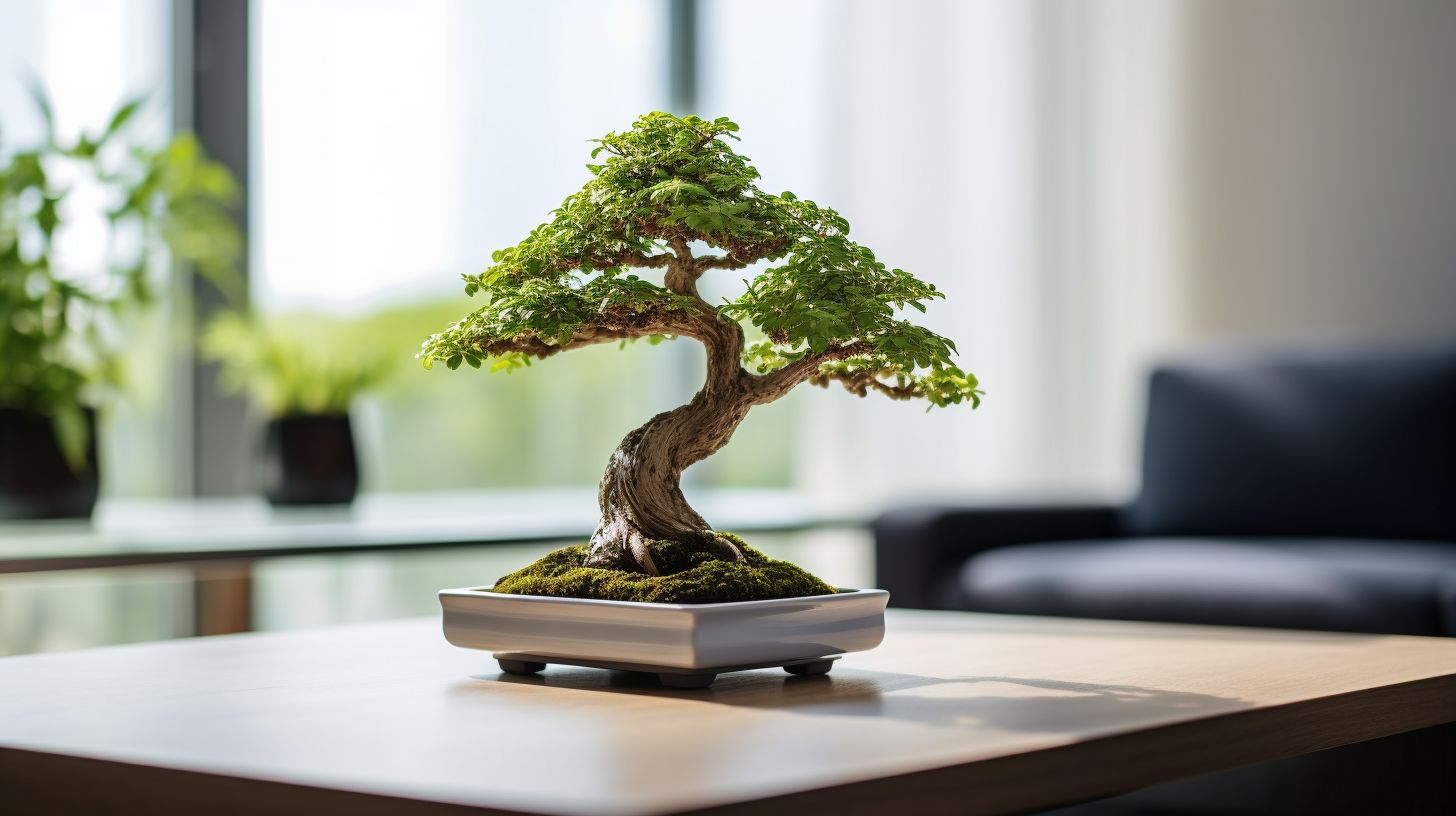
Are you struggling to find the perfect touch of nature for your home? Bonsai trees transform any room with their miniature majesty and calm presence. In this post, we’ll guide you through choosing and caring for the best indoor bonsai trees, ensuring success even if you’re a beginner.
Get ready to grow!
Key Takeaways
- Juniper, Chinese Elm, Azalea, Ficus, Dwarf Jade, and Serissa are some of the best types of indoor bonsai trees with unique care needs and aesthetic appeal.
- When selecting an indoor bonsai tree, it’s important to consider light requirements, whether you prefer a flowering or non-flowering variety, and ensure the species is safe for pets.
- Proper care for indoor bonsai trees includes adequate watering when soil feels dry to touch; pruning and wiring for shape; fertilizing regularly during growing season; repotting as necessary; preventing pests and diseases with regular inspection.
- Displaying your bonsai involves choosing a container that fits your home decor style along with positioning in areas with natural light. Attending exhibitions and seeking inspiration from experienced artists can enhance your enjoyment and success in growing these miniature trees.
- Engaging in the art of bonsai encourages learning through workshops or joining clubs where connections made with fellow enthusiasts can offer insights into advanced techniques for cultivating beautiful indoor bonsai trees.
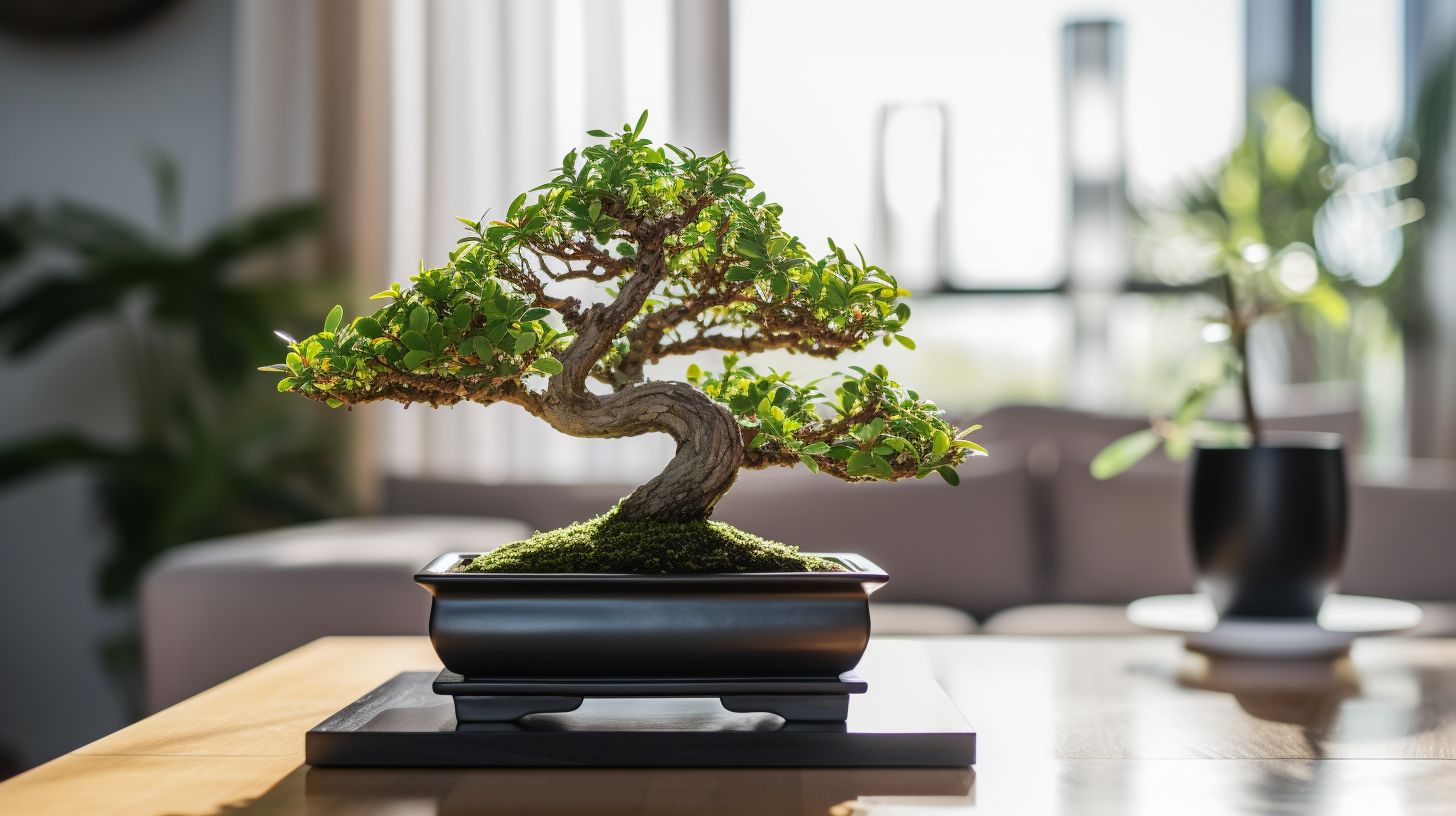
What to Consider When Choosing an Indoor Bonsai Tree
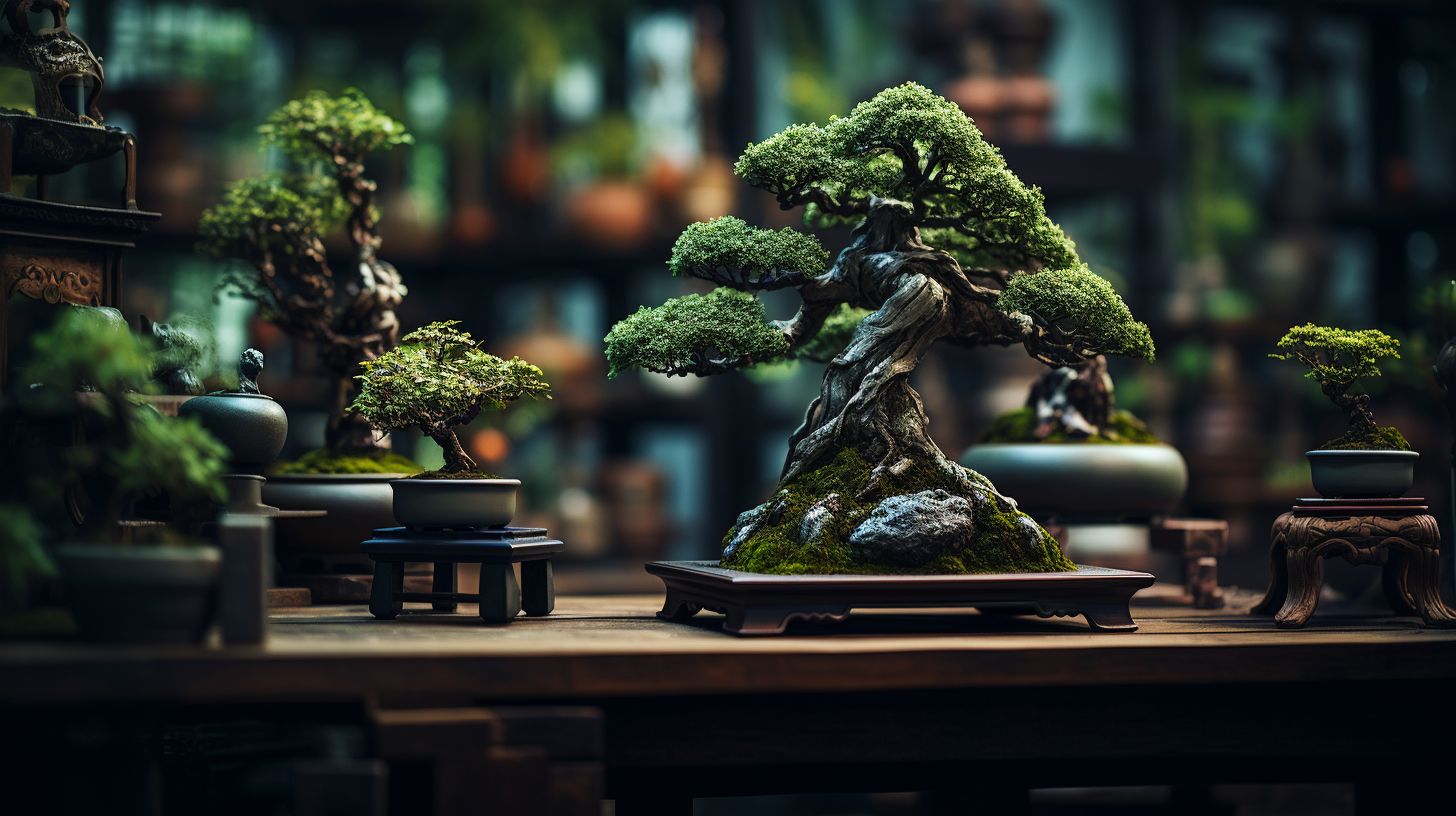

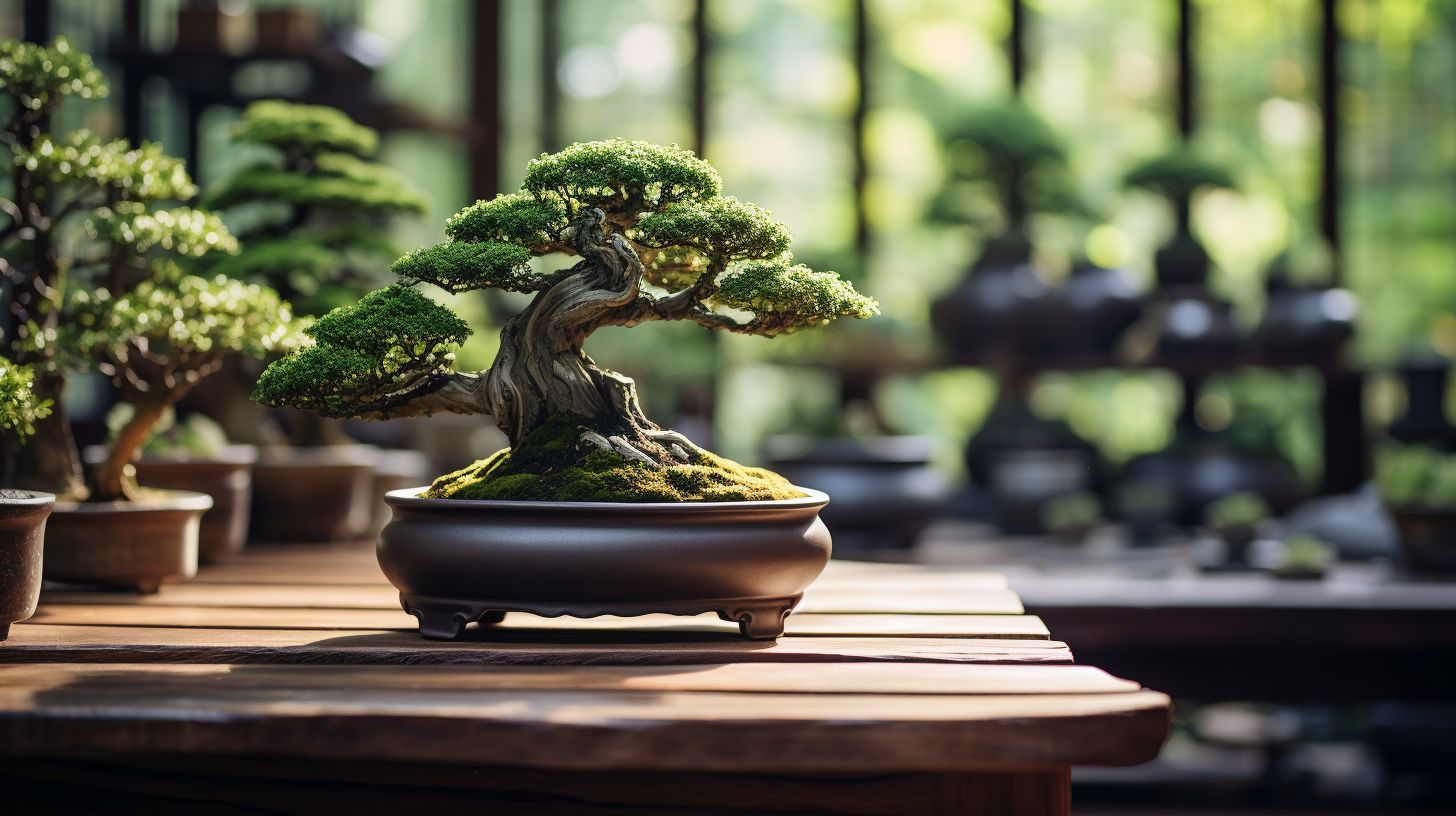
When choosing an indoor bonsai tree, it’s important to consider factors like light requirements, whether you want a flowering or non-flowering variety, and if you need a pet-friendly option.
These considerations will help you find the perfect bonsai tree for your home.
Light requirements

Bonsai trees need the right amount of light to thrive indoors. Place your best indoor bonsai trees where they’ll get at least five hours of sunlight daily. Your windowsill can be an excellent spot for them, especially if it’s facing south.
But careful not to scorch their delicate leaves; sometimes, indirect light works better than direct sun.
Make sure you rotate your bonsai regularly to ensure all sides get equal exposure to light. This helps keep your tree’s growth even and maintains its beautiful shape. If natural light in your home is lacking, consider using grow lights specifically designed for plants.
These can provide the consistent lighting conditions that some of the best trees for indoor bonsai require to stay healthy and vibrant.
Flowering or non-flowering
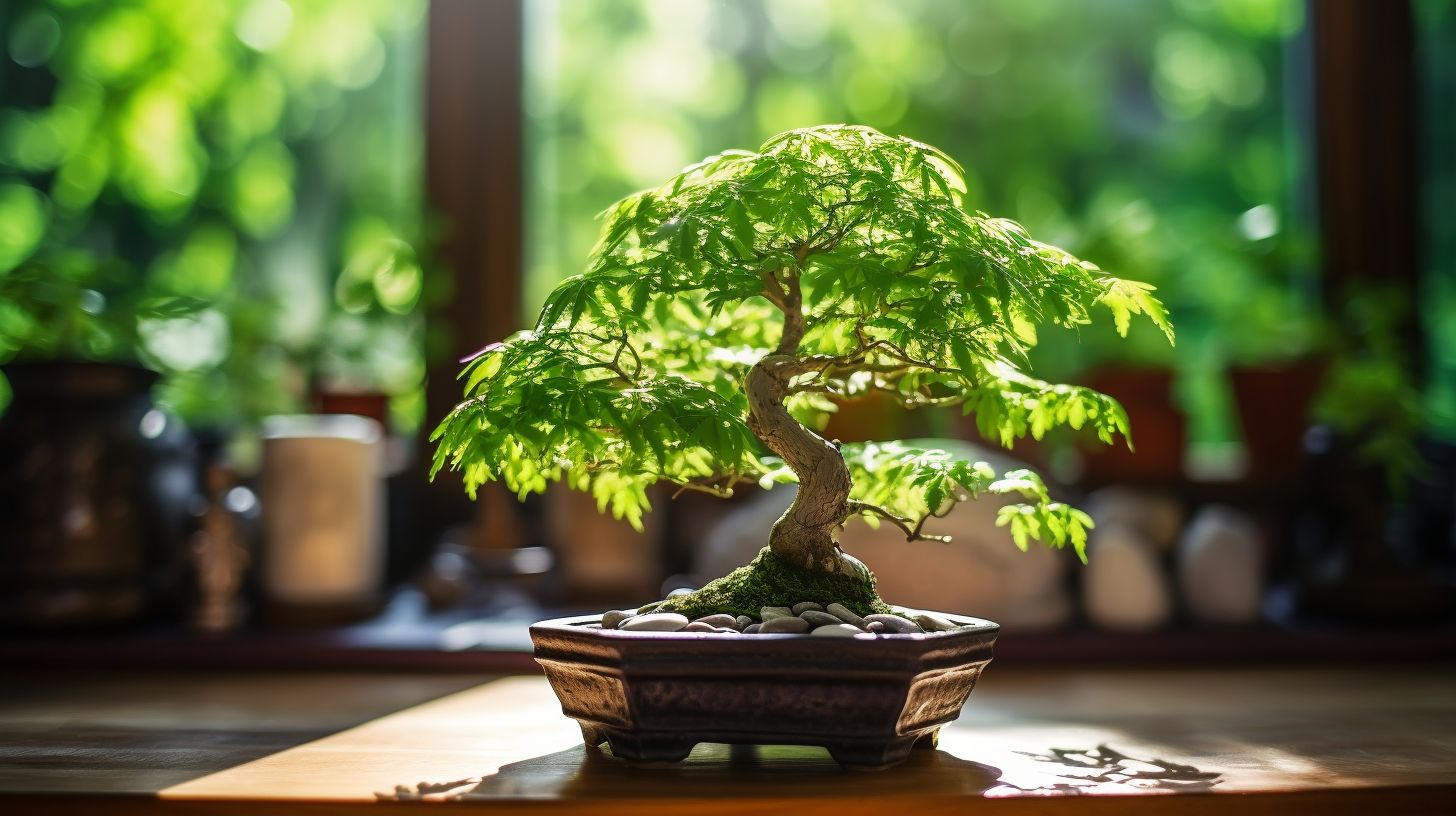
Choosing between flowering or non-flowering indoor bonsai trees is a matter of personal preference and style. Flowering bonsai like Azalea can bring a splash of color to your collection, captivating with blooms that add an extra layer of beauty to the miniature tree.
Non-flowering varieties such as Juniper offer a timeless elegance and focus on the artful shapes and textures of leaves and branches instead.
Consider how much time you’re willing to invest in maintenance, too. Flowering plants often require more care to ensure they bloom beautifully year after year. On the other hand, non-flowering types typically demand less attention, making them among the best indoor bonsai trees for beginners looking to start their journey into this ancient art form without feeling overwhelmed.
Pet-friendly options
Consider your furry friends when picking the best indoor bonsai trees to start your collection. Some plants can be toxic to pets if ingested, so it’s crucial to choose non-toxic varieties.
Safe bets include the dwarf jade (Portulacaria afra) and certain types of ficus. These pet-friendly options ensure you enjoy your hobby without worrying about your four-legged companions’ safety.
Keep in mind that even with non-toxic species, curious pets might still nibble on leaves or dig into the soil. To prevent any mishaps, place your bonsai trees out of reach or consider adding a barrier around them.
This way, both your pets and your miniature trees can coexist peacefully in your home.
Types of Indoor Bonsai Trees

Discover the variety of indoor bonsai trees available, such as Juniper, Chinese Elm, Azalea, Ficus, Dwarf Jade, and Serissa. Each type offers unique characteristics and care requirements to consider for your home.
Juniper
Juniper is an excellent choice for indoor bonsai trees, especially for beginners. These hardy evergreen trees require minimal maintenance and can tolerate a wide range of lighting conditions.
Junipers are known for their rugged, gnarled trunks and delicate foliage, adding a sense of age and maturity to your indoor bonsai collection. With proper care, they can even develop tiny blue or green berries, further enhancing their visual appeal.
As a pet-friendly option with adaptable light requirements, the Juniper bonsai tree offers versatility and aesthetic charm for any indoor space. What are the best trees for indoor bonsai.
Chinese Elm
Chinese Elm, also known as Ulmus parvifolia, is a popular choice for indoor bonsai enthusiasts due to its resilient nature and attractive aesthetics. This hardy tree features small, glossy leaves and intricate twigging that can be shaped into various styles through pruning and wiring techniques.
Chinese Elm thrives in bright, indirect light and prefers consistent watering to maintain soil moisture without becoming waterlogged. Its adaptability makes it suitable for different environments, making it an ideal option for beginners seeking a low-maintenance indoor bonsai tree.
With proper care and maintenance, Chinese Elm can develop a thick trunk with elegant bark texture, creating a mature appearance in a relatively short time frame. Its ability to tolerate brief periods of low light or irregular watering further adds to its appeal as an indoor bonsai tree.
Azalea
Azalea, a popular choice for indoor bonsai, is known for its vibrant and abundant blooms. This tree requires bright, indirect light to thrive and can be placed near an east or south-facing window.
When caring for your Azalea bonsai, ensure the soil remains moist but not waterlogged. Pruning and shaping should be done after the flowering period to encourage new growth and maintain its desired shape.
Choose a well-draining potting mix with good moisture retention when repotting your Azalea bonsai. Fertilize it regularly during the growing season to support healthy growth and flowering.
Ficus
The Ficus is a popular choice for indoor bonsai due to its resilience and adaptability. It thrives in moderate to bright light, making it suitable for various indoor environments. This tree’s small leaves and aerial roots create an intricate and eye-catching appearance, adding interest to your living space.
Regular pruning will help maintain the Ficus’s desired shape, promoting growth and enhancing its aesthetic appeal.
Moving on from the Ficus, let’s delve into caring for indoor bonsai trees with essential tips for watering and maintenance.
Dwarf Jade
Moving on from the Ficus, another popular choice for an indoor bonsai tree is the Dwarf Jade. This resilient and easy-to-care-for plant thrives in bright light and requires minimal watering.
Its small, glossy green leaves and thick trunk provide a visually appealing addition to any indoor space. With proper care, the Dwarf Jade can develop into an attractive miniature tree that adds a touch of natural beauty to your home or office.
While the Dwarf Jade may not produce showy flowers, its compact size and low-maintenance nature make it an ideal option for beginners or those with limited time for plant care. An excellent choice for bonsai enthusiasts seeking a durable and adaptable tree, this species offers year-round interest with its unique appearance and effortless upkeep.
Serissa
Moving on from Dwarf Jade, let’s explore the elegant Serissa bonsai. Also known as snowrose or tree of a thousand stars, the Serissa is prized for its delicate white flowers and tiny dark green leaves.
This charming evergreen thrives indoors and can be shaped into various styles such as informal upright or cascade. While it requires a bit more attention to watering and humidity levels, the stunning beauty of the Serissa makes it a rewarding choice for indoor bonsai enthusiasts.
When caring for your Serissa bonsai, ensure it receives bright but indirect sunlight and keep the soil consistently moist without waterlogging. Regular misting will help maintain adequate humidity levels to support its growth.
How to Care for Indoor Bonsai Trees
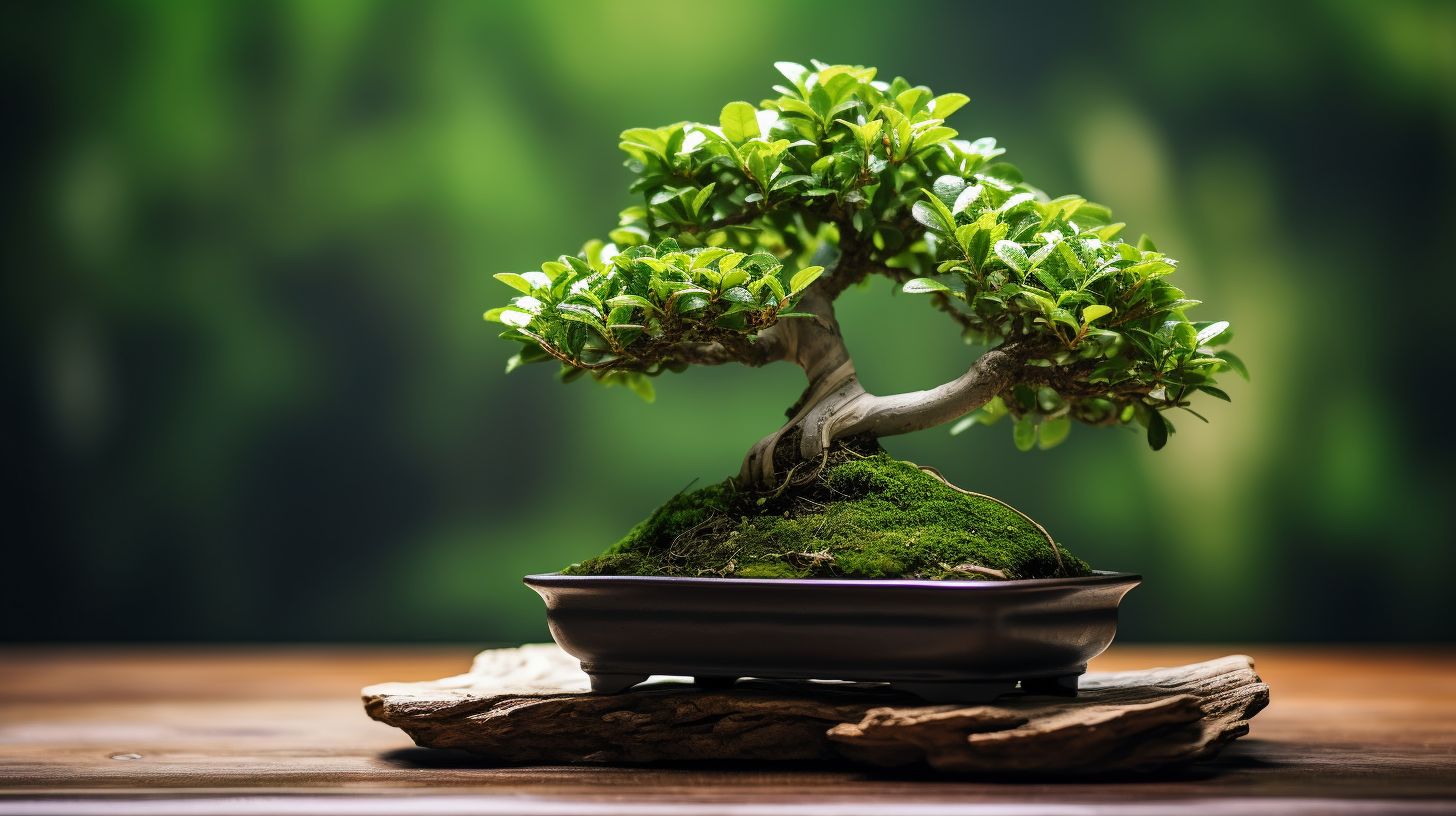


Regularly water your indoor bonsai tree, prune and wire it as needed, fertilize the soil, repot when necessary, and take precautions to prevent pests and diseases. Learn more about how to care for your indoor bonsai trees by reading the full article!
Watering
Water your indoor bonsai trees when the top of the soil feels dry to the touch. Use a small watering can with a narrow spout to water your tree thoroughly. Water until you see moisture coming out of the drainage holes at the bottom of the pot.
During warmer months, check your bonsai’s soil every day to ensure it doesn’t dry out completely. Adjust your watering schedule as needed based on seasonal changes and humidity levels in your home.
Remember, overwatering can lead to root rot, so it’s crucial not to let your indoor bonsai sit in waterlogged soil.
Pruning and wiring
After ensuring your bonsai tree receives the correct amount of water, the next crucial step in its care is pruning and wiring. Pruning helps shape the tree by removing unwanted branches and encouraging new growth in desired areas.
It also contributes to overall tree health by allowing for better airflow and light penetration. Additionally, wiring allows you to gently guide the branches into aesthetically pleasing shapes or positions, adding an artistic touch to your indoor bonsai tree.
Regular maintenance through pruning and wiring ensures that your bonsai stays healthy and visually appealing.
When it comes to pruning your indoor bonsai, make sure to use sharp shears or scissors designed specifically for this purpose. You should remove any dead, damaged, or crossing branches while paying attention not to cut away too much foliage at once.
As for wiring, be gentle when wrapping the wires around branches to avoid damaging them. Keep an eye on wired branches as they grow, adjusting the wire if needed to prevent it from cutting into the bark.
Fertilizing
To maintain the health of your indoor bonsai tree, fertilize it regularly during the growing season. Use a balanced liquid fertilizer to provide essential nutrients for robust growth and overall well-being.
Apply the fertilizer at half-strength every two weeks, ensuring that the soil is moist before feeding to avoid root burn.
Conduct a soil test annually to determine if your bonsai requires additional nutrients beyond what is provided by regular fertilization. Adjust your fertilizer regimen based on the results of the soil test, helping you ensure that your indoor bonsai tree continues to thrive in its environment.
Repotting
When repotting your indoor bonsai tree, carefully remove it from its current pot and trim any roots that are circling the root ball. Gently comb out the roots to encourage new growth before placing the tree in fresh, well-draining soil.
Repotting is essential for maintaining the health and growth of your indoor bonsai tree. It allows for better nutrient absorption and prevents root-bound issues, promoting a strong foundation for your tree’s overall well-being.
Moving on to “Preventing pests and diseases,” let’s explore how to keep your indoor bonsai trees healthy and vibrant.
Preventing pests and diseases
To prevent pests and diseases, inspect your indoor bonsai regularly for any signs of infestation or illness. Keep an eye out for common issues like aphids, spider mites, and scale insects.
If you notice any pests or diseases, take proactive measures such as isolating the affected tree, using organic pest control methods, or seeking advice from a local nursery. Additionally, maintain proper air circulation around your bonsai to discourage fungal growth and keep the foliage dry to prevent mold and mildew.
Ensuring a healthy environment is crucial in safeguarding your indoor bonsai trees from potential threats. Implementing regular checks and taking swift action when necessary will help maintain the resilience of your plants against pests and diseases while promoting their overall well-being.
Tips for Displaying Indoor Bonsai Trees

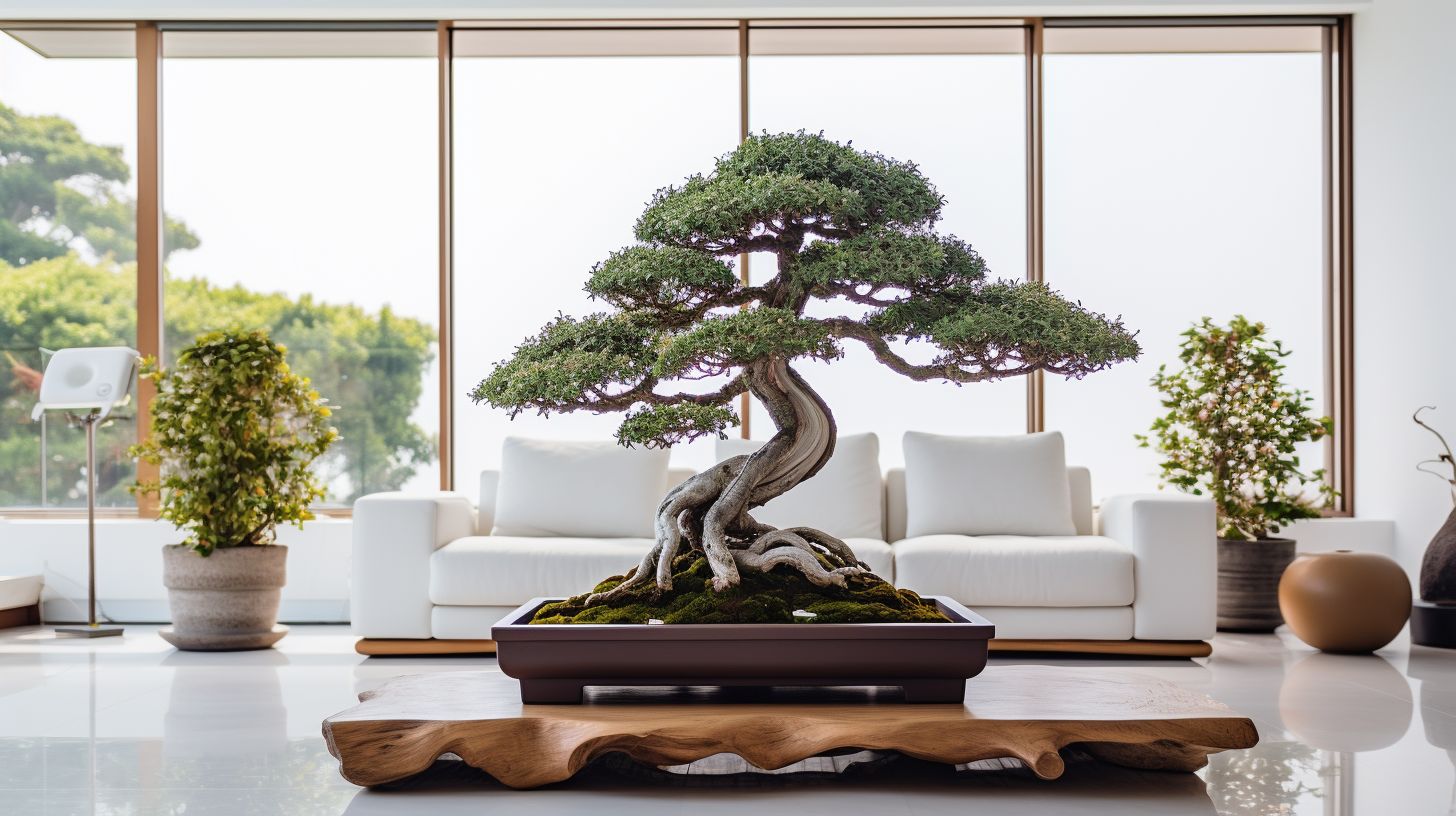
Choose a container that complements your home decor and creates a bonsai display area that showcases your trees beautifully. Find inspiration from bonsai artists and attend exhibitions to learn more about displaying indoor bonsai trees.
To read more on these tips and other valuable information about indoor bonsai trees, keep reading!
Choosing the right container
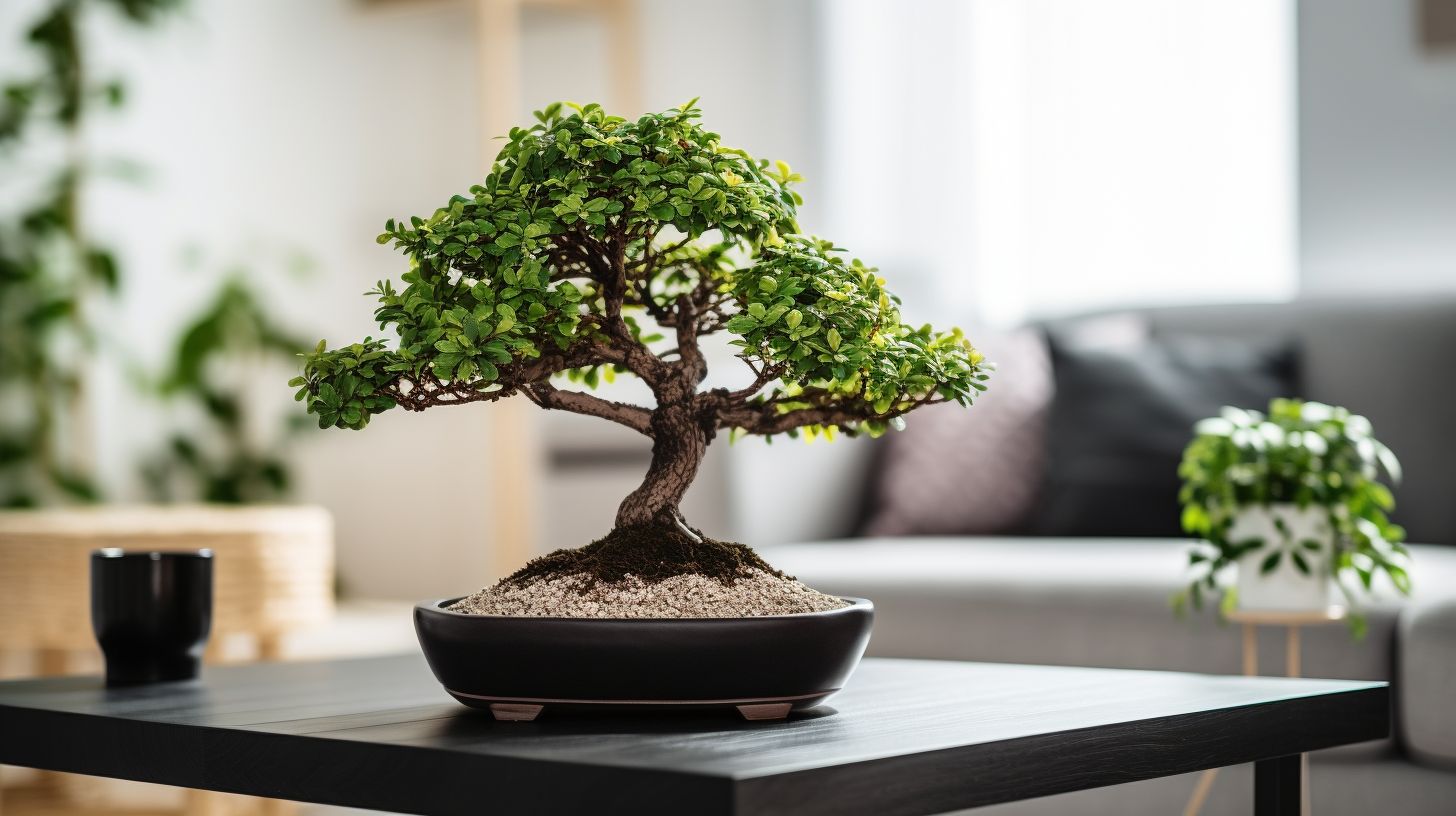
Selecting the right container for your indoor bonsai tree is crucial. Consider the size and style of the pot, ensuring it complements the tree’s aesthetics. Ensure that the container has drainage holes to prevent waterlogging.
Choose a shallow pot to promote root growth and stability, allowing oxygen to reach the roots easily. Opt for a ceramic or clay pot as they are porous, aiding in moisture evaporation and providing better insulation for the roots.
When positioning your bonsai in its new container, place a layer of mesh over the drainage holes before adding soil to avoid clogging. Then, gently spread out the root system before securing it with fresh soil.
Incorporating bonsai into home decor
When choosing the right container for your indoor bonsai tree, consider how it will complement your home decor. Incorporating a bonsai into your living space can add a touch of nature and tranquility to any room.
You can place the bonsai on a stand or table to create a focal point, or use it as part of a larger arrangement with other plants. Bonsai trees can also be incorporated into shelves, alcoves, or even hung from the ceiling to bring an unexpected element to your interior design.
To blend seamlessly with your home decor, select containers that match the style and color scheme of the room where you’ll display them. A well-placed bonsai tree can make a striking visual impact while bringing harmony and balance to your living space.
Creating a bonsai display area
Choose a location with plenty of natural light for your indoor bonsai display area. Position the trees on a table, shelf, or stand to showcase their unique features. You can also use accent lighting to highlight specific trees or create an inviting ambiance in the display area.
Organize the space by placing larger trees at the back and smaller ones towards the front to create depth and visual interest. Consider adding decorative elements such as figurines, stones, or miniature lanterns to enhance the overall presentation.
By curating a captivating bonsai display area, you can enjoy these beautiful creations while adding a touch of nature to your home decor.
Attending bonsai exhibitions

After creating a bonsai display area in your home and gaining inspiration from bonsai artists, attending bonsai exhibitions can further expand your knowledge and appreciation for this ancient art form.
These exhibitions provide an opportunity to see a wide variety of stunning bonsai trees up close, learn from experienced growers and enthusiasts, and discover new techniques for caring for your own indoor bonsai trees.
Additionally, you can connect with like-minded individuals who share the same passion for cultivating these miniature masterpieces. Bonsai exhibitions offer a rich experience that can deepen your understanding of the artistry and skill involved in growing beautiful indoor bonsai trees.
Finding inspiration from bonsai artists
Explore the captivating work of bonsai artists through books, online galleries, and local exhibitions. Observing their skillful techniques and unique designs can spark creativity for your own indoor bonsai trees.
Take note of their use of color, shape, and texture to infuse fresh ideas into your own displays.
Immerse yourself in the world of bonsai by attending workshops or joining clubs where you can connect with experienced enthusiasts and learn from their collective knowledge. Engaging with fellow hobbyists will provide valuable insights and inspiration for nurturing your indoor bonsai trees to their fullest potential.
Conclusion
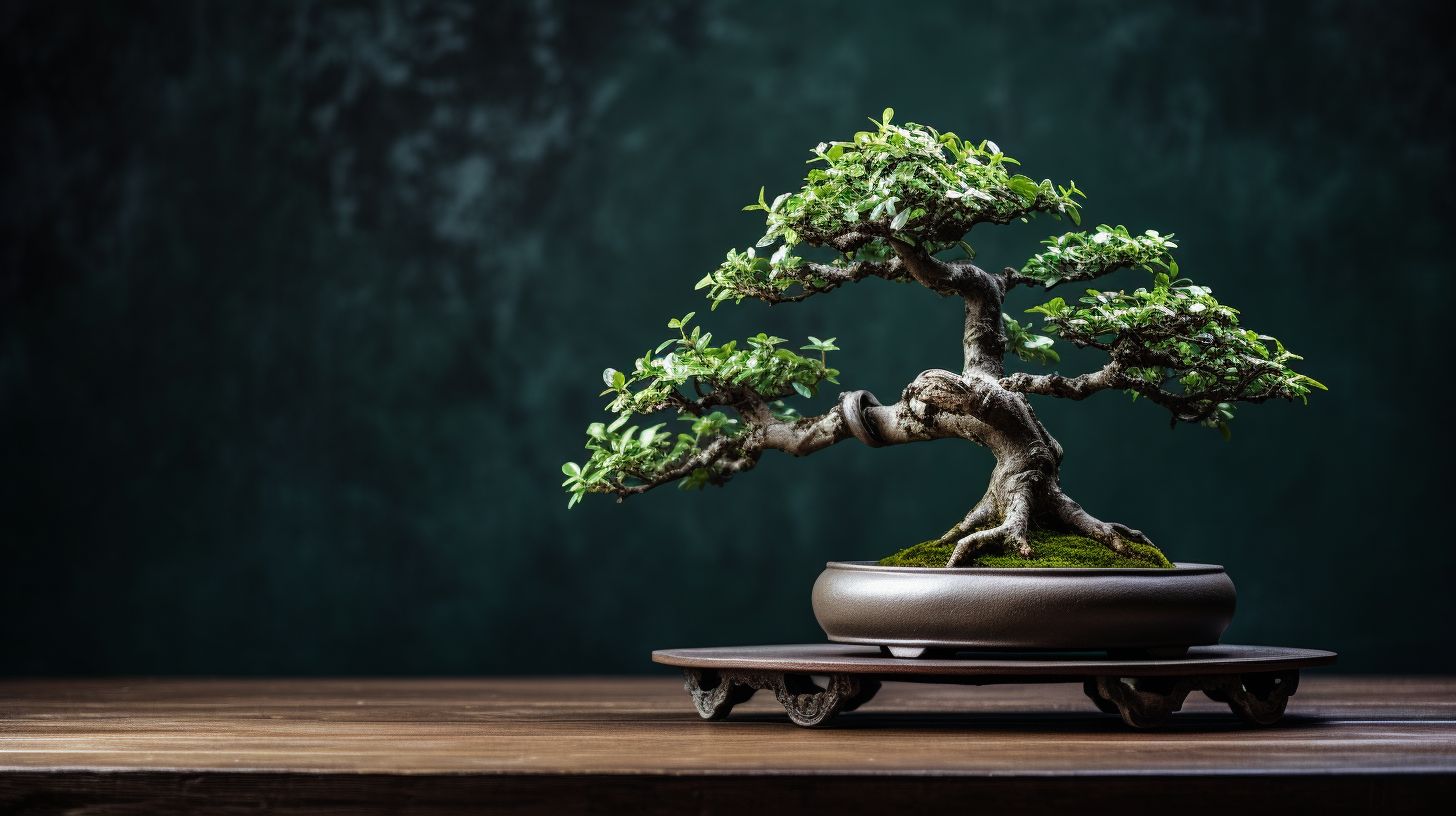
In conclusion, choosing the best indoor bonsai tree involves considering light requirements, whether you want a flowering or non-flowering variety, and if it’s pet-friendly. Types of indoor bonsai trees include Juniper, Chinese Elm, Azalea, Ficus, Dwarf Jade, and Serissa.
Caring for them entails proper watering, pruning and wiring as needed, regular fertilizing and repotting when necessary to prevent pests and diseases. To display these beautiful plants at their best: choose the right container; incorporate them into your home decor; set up a designated bonsai area; attend exhibitions for ideas and find inspiration from talented artists in this unique field of nature artistry!
FAQs
Sure, here are the 4 FAQs about “Best Indoor Bonsai Trees” without specific keywords provided:
1. What makes a bonsai tree good for indoors?
A bonsai that’s good for indoors usually needs less sunlight and can thrive in the steady temperatures found inside your home.
2. How do I choose an indoor bonsai tree?
Look for bonsai trees known to do well indoors like Ficus or Jade plants, and pick one that you can care for according to its specific needs.
3. Can all bonsai trees grow inside?
Not all species are suited for indoor growth; some need the changing conditions outdoors to flourish properly.
4. What do I need to keep my indoor bonsai healthy?
Your indoor bonsai will need proper watering, enough light but not direct sun, and regular trimming to stay healthy and beautiful.